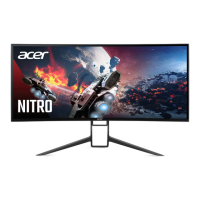
Do you have a question about the Acer XR343CK and is the answer not in the manual?
Read and follow all safety warnings and instructions for proper use.
Details normal LCD behavior like flickering, brightness variations, pixel issues, and afterimages.
Covers cleaning, accessibility, and safe listening practices for optimal user experience.
Proper operation from the correct power source, cord usage, and grounding for electrical safety.
Important warnings regarding electrical connections, grounding, and preventing shock hazards.
Advises against self-servicing and refers all repairs to qualified personnel.
Warns against operating the device in areas with potentially explosive atmospheres.
Mentions small parts safety and Acer's IT equipment recycling commitment.
Recommends recycling electronic devices according to WEEE regulations.
Explains normal pixel variations and that they do not constitute a malfunction.
Addresses risks of prolonged computer use and offers tips for finding a comfortable posture.
Suggestions to reduce eyestrain, including eye rests, blinking, and display adjustments.
Encourages regular breaks, stretching, and maintaining a healthy lifestyle for productivity.
Lists items included in the box and advises saving packing materials.
Explains the use of Velcro to secure height adjustment.
Step-by-step guide for adjusting the monitor's height.
Instructions for adjusting the monitor's tilt angle.
Instructions for adjusting the monitor's swivel angle.
Instructions for attaching an optional wall mount arm to the monitor.
Overview of physical buttons, joystick, and their functions.
Step-by-step guide for connecting signal and power cables to the monitor.
Details on connecting the AC power cord and adapter for operation.
Explains the monitor's power saving mode and its visual indicator.
Describes the DDC protocol for plug-and-play functionality.
Pinout configurations for 20-pin and 19-pin display signal cables.
Pinout diagram and pin assignments for the 24-pin USB Type C cable.
Lists supported display modes, resolutions, and refresh rates.
Overview of the main OSD interface and its elements.
How to use Hot Key 1 to select display modes like Action, Racing, Sports.
How to adjust monitor brightness using Hot Key 2.
How to switch input sources using Hot Key 3.
Guide to navigating and using the main OSD menu.
Adjusts brightness, contrast, enhances shadows, and filters blue light for eye comfort.
Dynamically adjusts contrast, HDR, brightness via sensor, and image sharpness.
Adjusts luminance, color temp, blue light, and user-defined color parameters.
Selects preset modes, color space, grayscale, and hue/saturation for colors.
Adjusts audio volume level and enables/disables mute function.
Optimizes response time, enables FreeSync, and reduces input latency.
Displays refresh rate and enhances gameplay visuals with VRB.
Displays an on-screen aim point for shooting games.
Configures OSD language, timeout duration, and transparency.
Prevents unauthorized access to the OSD menu by locking it.
Selects input source, enables auto-source detection, and sets DP format.
Configures screen aspect ratio and Picture-in-Picture/Picture-by-Picture modes.
Assigns hotkey functions and enables remote PC configuration via DDC/CI.
Adjusts HDMI black level, speeds up boot, and selects USB port type.
Allows USB charging functionality even when the monitor is turned off.
Saves current display configurations to user-defined game modes.
Provides remedies for common problems like "No picture visible" in HDMI/DP modes.